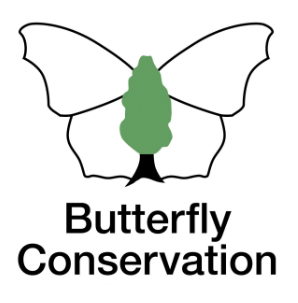Brown Argus
Brown Hairstreak
Chalkhill Blue
Clouded Yellow
Comma
Common Blue
Dark Green Fritillary
Dingy Skipper
Essex Skipper
Gatekeeper
Green Hairstreak
Green-veined White
Grizzled Skipper
Holly Blue
Large Skipper
Large White
Marbled White
Meadow Brown
Orange-tip
Painted Lady
Peacock
Purple Emperor
Purple Hairstreak
Red Admiral
Ringlet
Silver-washed Fritillary
Small Blue
Small Copper
Small Heath
Small Skipper
Small Tortoiseshell
Small White
Speckled Wood
Wall
White Admiral
White-letter Hairstreak
Extinct/rare immigrants
Red Admiral
Vanessa atalanta
General Distribution and Status
The Red Admiral is a common summer visitor found throughout Britain with varying numbers each year. It was thought that very few individuals survive our winters but in recent years probably due to climate change, more specimens, adults and immature stages, have been reported in the coldest months of the year in the south of England. It appears to be more abundant now but with the monitoring scheme not including counts for October, when the butterfly can be seen in high numbers, it is difficult to interpret trends precisely (Asher et al.). Nevertheless, since the 1970s, figures show that abundance has more than tripled which is likely to be a result of increased migration from the Continent. There is more evidence now of a reverse southward migration taking place in the autumn. In Hertfordshire and Middlesex, similar trends of abundance are shown with evidence of more very early sightings suggesting that overwintering by adults and larvae is more prevalent (Wood, 2016).
| United Kingdom | Herts & Middx | |||
| Distribution | 1976-2019 | +14% | 1980-2015 | +15% |
| Average 10-year trend | +3% | 2006-2015 | +18% | |
| 2024 since 2015-19 | +15% | |||
| Abundance | 1976-2024 | +311% | 1980-2015 | +36% |
| 2015-2024 | +70% | 2006-2015 | -57% | |
| 2023-2024 | -70% | 2024 since 2015-19 | -11% | |

UK distribution map
UKBMS Species summary
Habitat Requirements
This species can be seen in every habitat type including parks and gardens although it is less common on arable land.
Larval Foodplants
Common Nettle Urtica dioica. Hop Humulus lupulus and Pellitory-of-the-Wall Parietina diffusa are other foodplants reported (Sawford). I found an egg laid on Ground Ivy Glechoma hederacea at Knebworth Park in December 2017 but this plant was in very close proximity with some nettles so this event is probably not of any significance.
Adult Food Sources
Buddleia Buddleja davidii (1299), Ivy Hedera helix (432), Iceplant Sedum spectabile (192), Apple fruit Malus domestica (191), Confused Michaelmas Daisy Aster novi-belgii (177).
Historical Records
It was probably a common and well-known migrant for many centuries. The first record mentioned for the Stevenage area was by Herbert Matthews around 1900 (Gibbs). Foster's 1937 report refers to it as 'sometimes common'; Ray Palmer describes it as 'very abundant' in the autumn of 1930. Other good years according to the literature are 1955, 1958, 1959, 1961, 1964 and 1969 (Bell 1957, 1960, 1961, 1964, 1966, 1970) but curiously I did not find any mention of its abundance in the warm summers of the 1940s. Waterton's 1970-81 report notes its relative scarcity in the latter half of the 1970s.
Local Distribution and Abundance
As indicated on the map, the butterfly is well distributed in the Stevenage area. The highest populations recorded were in Old Stevenage: 17 at St. Nicholas Churchyard on 14 September 2011 and 15 at Great Ashby on 4 August 2021. The map shows that the TL22L tetrad harbours the largest total because proportionately many more visits were made to this tetrad over the whole survey period. 2023 was easily the best year for number of reports (420) with the highest ever counts too including 46 in central Stevenage on 16 July.

Stevenage (South Fairlands Valley Park) transect 1993-2025
The counts recorded do not always reflect what is happening elsewhere with the trend showing a slightly negative stance although 2019 saw a rise as most were probably migrants. Relatively few are seen here in September. Perhaps favoured food sources like flowering ivy and rotting fruit, readily available elsewhere attract the Red Admirals away from this transect site at this time of year.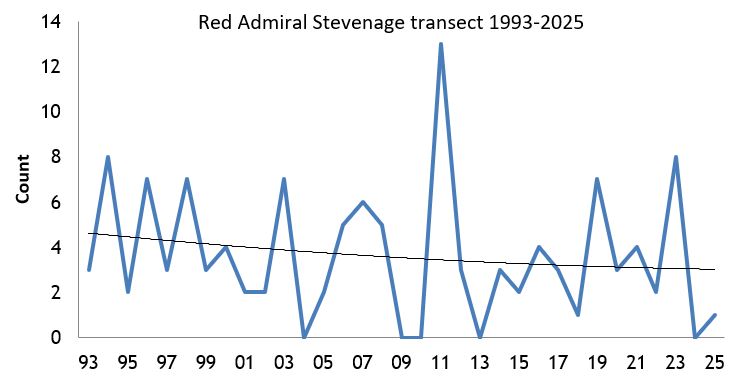
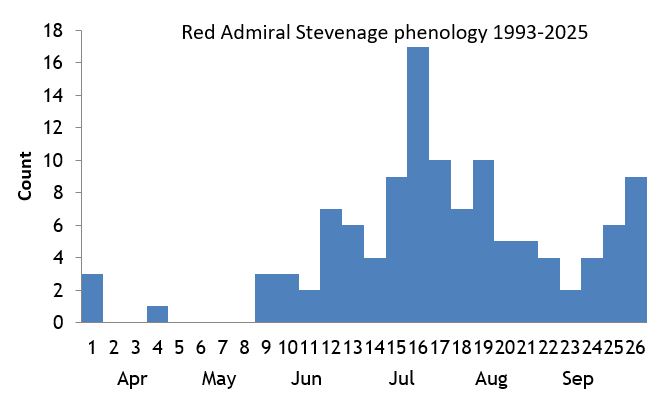
Knebworth Park transect 1996-2010 and 2017-2025
Numbers fluctuate here as expected with specimens scattered throughout the transect.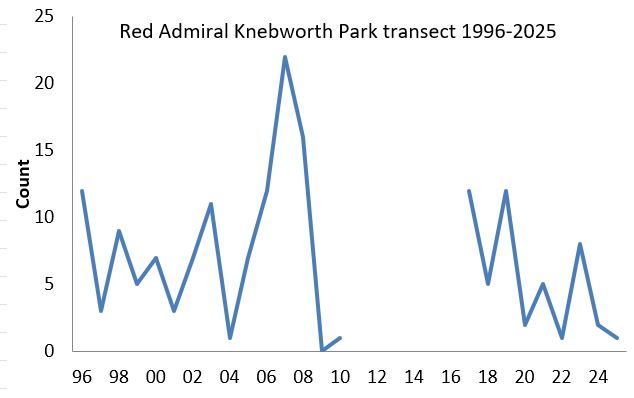
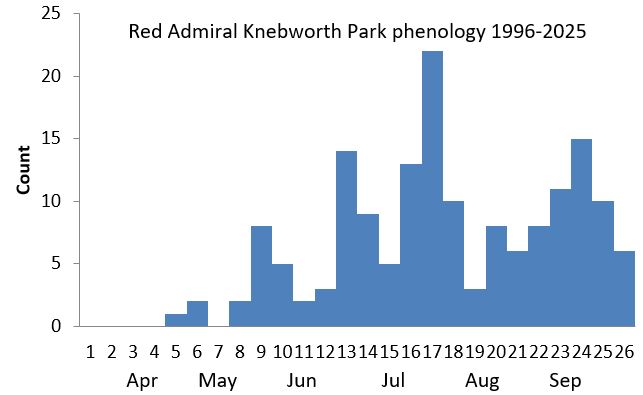
Knebworth Woods transect 2017-2025
As expected, more Red Admirals were met with in 2017, 2019 and 2023 owing to a larger influx from Europe. The majority were seen along the rides near Pigeonswick Cottage and the track at Norton Green Common. On 19 July, 2023 16 specimens were counted including 13 on the north-south ride west of Newton Wood.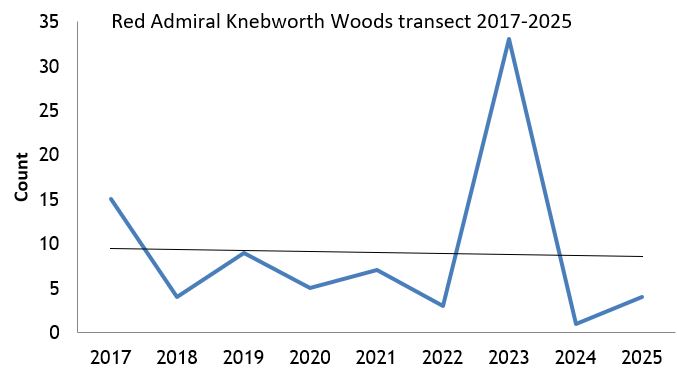
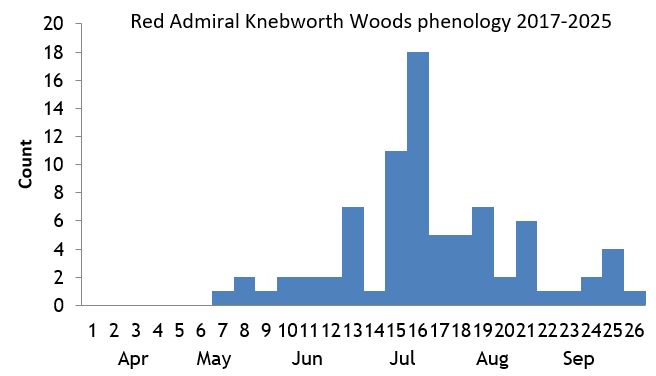
Pryor's Wood transect 2000-2022
This species is an occasional visitor with only three seen since 2007: on 10 July 2015, 29 July 2019 and 28 June 2022.Life History
Earliest date: 5 January 2013 at Bronte Paths, Stevenage
Latest date: 20 December 2011 near Hampson Park
The Red Admiral
can probably now be considered as a resident species because there is ample evidence of successful overwintering in the adult stage and possibly also
in an immature stage since many specimens are now seen in the early spring before the migrants arrive in May and June. Eggs and larvae were found in Knebworth Park and Fairlands Valley Park in December 2017 and January 2018 so at least some Red Admirals will attempt
to overwinter in supposedly the larval stage. The migrants and any overwintered or spring individuals will produce a new generation later in the summer,
often reaching a peak in September which may be supplemented by another influx from Europe. Eggs are laid singly on the upper surface of fresh leaves most often
in a sunny but sheltered spot. Larvae form silken tents using the edges of a leaf. Pupation takes places within one of these tents.
Behaviour/Observation notes
Males in spring and early summer are largely territorial along woodland rides, for example, and are difficult to approach. However, in late summer and autumn, when both sexes are feeding on flowers in gardens, ivy in hedgerows or rotting fruit then they are more approachable for close-up photographs.
Variations/Aberrations
There are several aberrations, of which the most common is ab. bialbata where the red bands on the forewings show a white
spot (see photo on the right). It is thought that around one in six specimens have this white spot. Other aberrations reported in Hertfordshire include ab.
flavescens where the red bands on the hindwings are replaced by yellow seen by Valerie Carter at Forty Hill in 2002 (Murray
& Wood) and ab. edwardsi(?) where the red bands on the forewings are replaced by orange spotted by David Claridge in 1998
(Murray & Souter).
Find out more on the UK Butterflies website
References
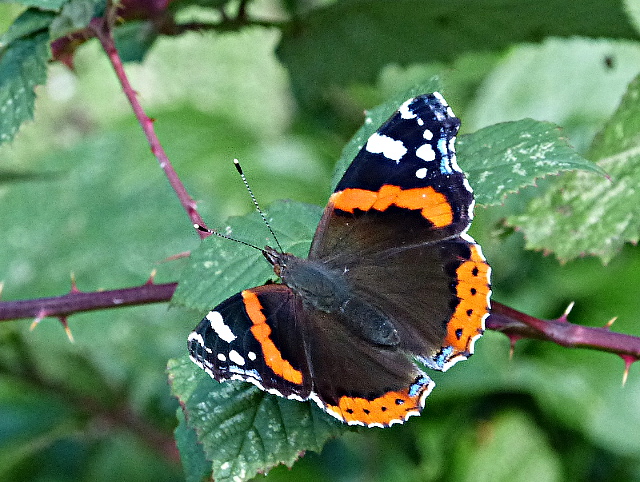
Fairlands Valley Park 4 Oct 2016
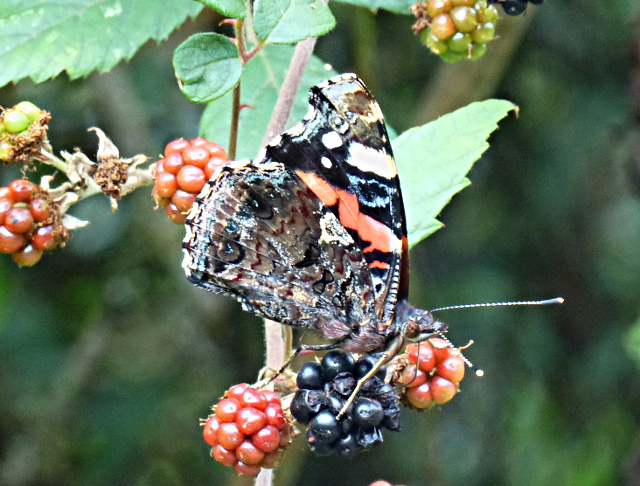
Norton Green Farm 7 Sep 2016
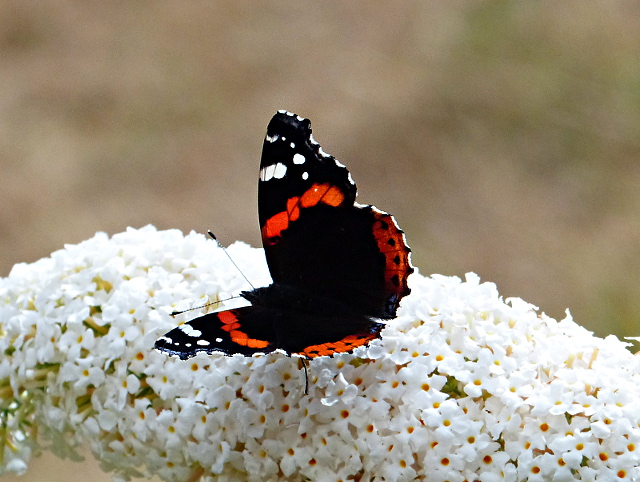
Stevenage garden 25 Aug 2016 ab. bialbata
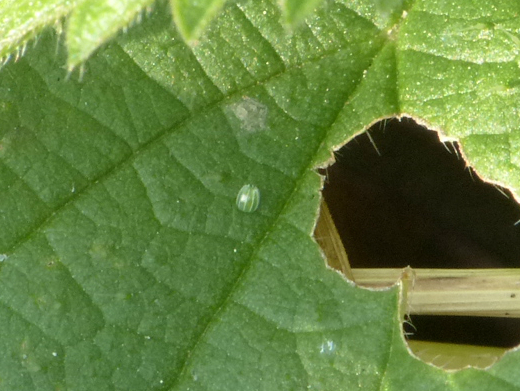
Egg Knebworth Park 3 Nov 2017
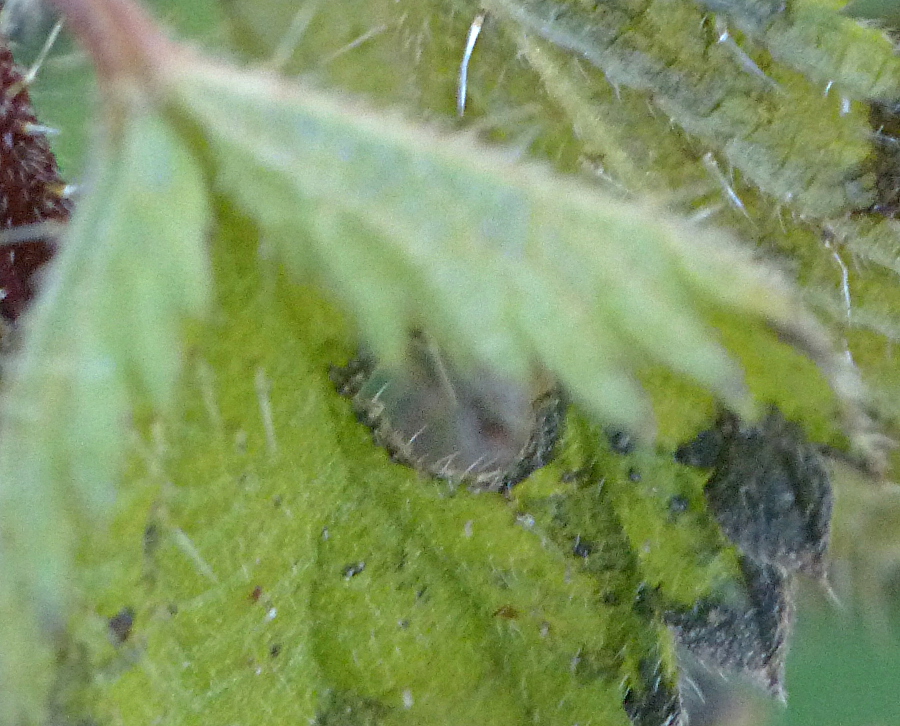
Larvae Knebworth Park 9 Dec 2017
